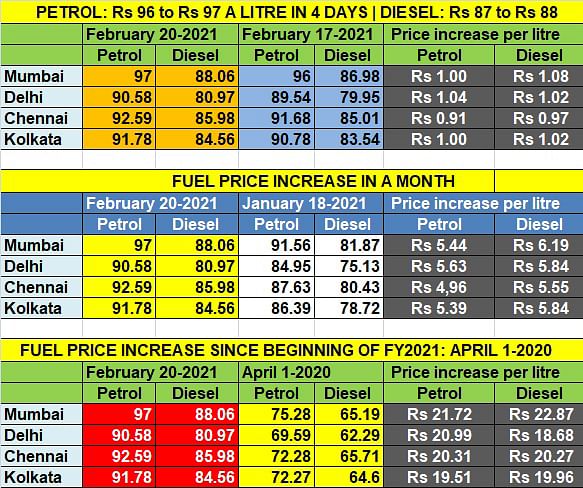Petrol takes just 4 days to go from Rs 96 to Rs 97 a litre
Fuel prices rise for 11th straight day in India. At the current rate, the Rs 100-a-litre price for petrol in Mumbai could be breached in another 12 days.
Prices of petrol and diesel have risen for the 11th straight day in India, continuing to scale record highs. If current fuel price rise trends are any indication, then the Rs 100-a-litre price for petrol in Mumbai, India’s financial capital, could be breached in another 12 days. From February 17, when petrol hit Rs 96 a litre, to today – February 20 – when it has scaled Rs 97 – the 100 paise or Rs 1-increase has taken just 4 days.
Diesel, once touted as the ‘common man’s fuel’, also bears the brunt of price increase. From February 17’s Rs 86.98 a litre, it costs Rs 88.06 a litre today – up by Rs 1.08 a litre.

A look at the three fact-laden data tables above reveal just how petrol and diesel prices have risen over the past four days, one month and 10-and-a-half months across four key metro cities – Mumbai, Delhi, Chennai and Kolkata.
Taking Mumbai as the benchmark for price rise in metros, price for a litre of petrol has risen by Rs 1.00, Rs 5.44 and Rs 21.72 and that of diesel by Rs 1.08, Rs 6.19 and Rs 22.87 over four days, one month and 10-and-a-half months respectively.
While the unabated increase in fuel prices in India has been set off by the sharp rise in global crude prices, the fact of the matter is that taxes account for a substantial portion of the retail price of petrol and diesel in the domestic market. Central and state government account for around 61% of petrol and 56% of diesel retail prices.
India is hugely dependent on oil imports – around 84% – to meet its fuel needs and any spike in global crude oil prices has a direct bearing on the economy. More than two-thirds of the oil import is from the Middle East. Other factors impacting fuel prices include the rupee-to-US-dollar exchange rate, global cues and global demand for fuel.
The price differential between the two fuels, which was Rs 10.09 a litre at the start of the fiscal year FY2021 on April 1, 2020, is today down to Rs 8.94 a litre, indicating the speedier price increase in diesel, which is the fuel used by scores of commercial vehicles crisscrossing the country and transporting essential goods and directly contributing to overall inflation. Not surprisingly, transporters – as well as millions of motorists – are worried.
It is understood that following a governing council meeting last week, the All-India Motor Transport Congress (AIMTC) has issued a 14-day ultimatum to the government, threatening to suspend transport services across the country.
Taxes make up for over 61% of retail petrol price and 56% diesel. The retail price of the two fuels is made up of three components – base price that reflects the cost of international oil, central excise duty and state taxes. Both Central and State governments rely heavily on collections from taxes on these products for meeting their developmental and welfare priorities. On February 12, Assam announced a price cut of Rs 5 per litre on petrol and fuel. Will other states follow suit?
RELATED ARTICLES
Cosmo First diversifies into paint protection film and ceramic coatings
The Aurangabad, Maharashtra-based packaging materials supplier is leveraging its competencies in plastic films and speci...
JSW MG Motor India confident of selling 1,000 M9 electric MPVs in first year
The 5.2-metre-long, seven-seater luxury electric MPV, which will be locally assembled at the Halol plant in Gujarat, wil...
Modern Automotives targets 25% CAGR in forged components by FY2031, diversifies into e-3Ws
The Tier-1 component supplier of forged components such as connecting rods, crankshafts, tie-rods, and fork bridges to l...






 20 Feb 2021
20 Feb 2021
 31157 Views
31157 Views





 Autocar Professional Bureau
Autocar Professional Bureau




